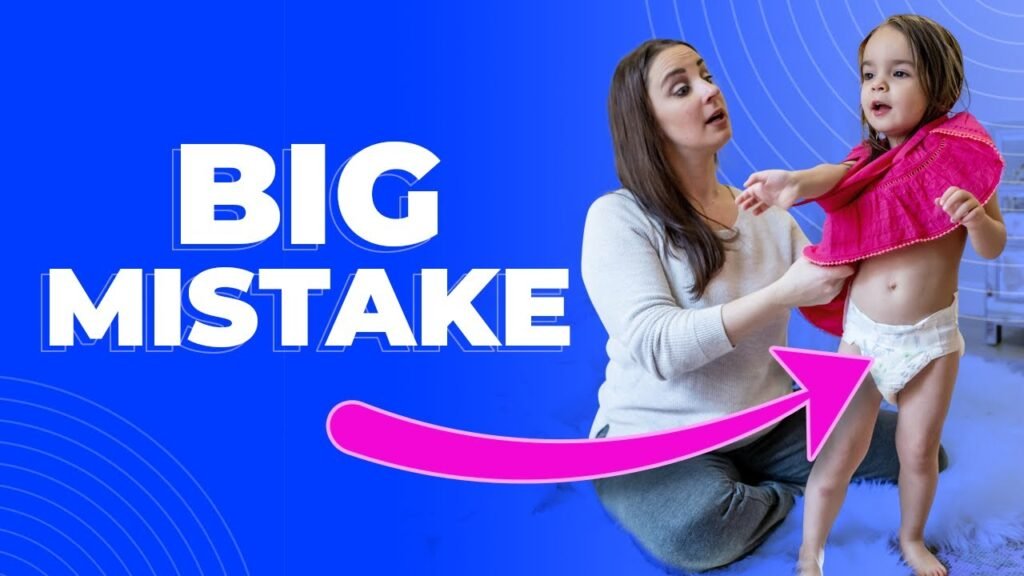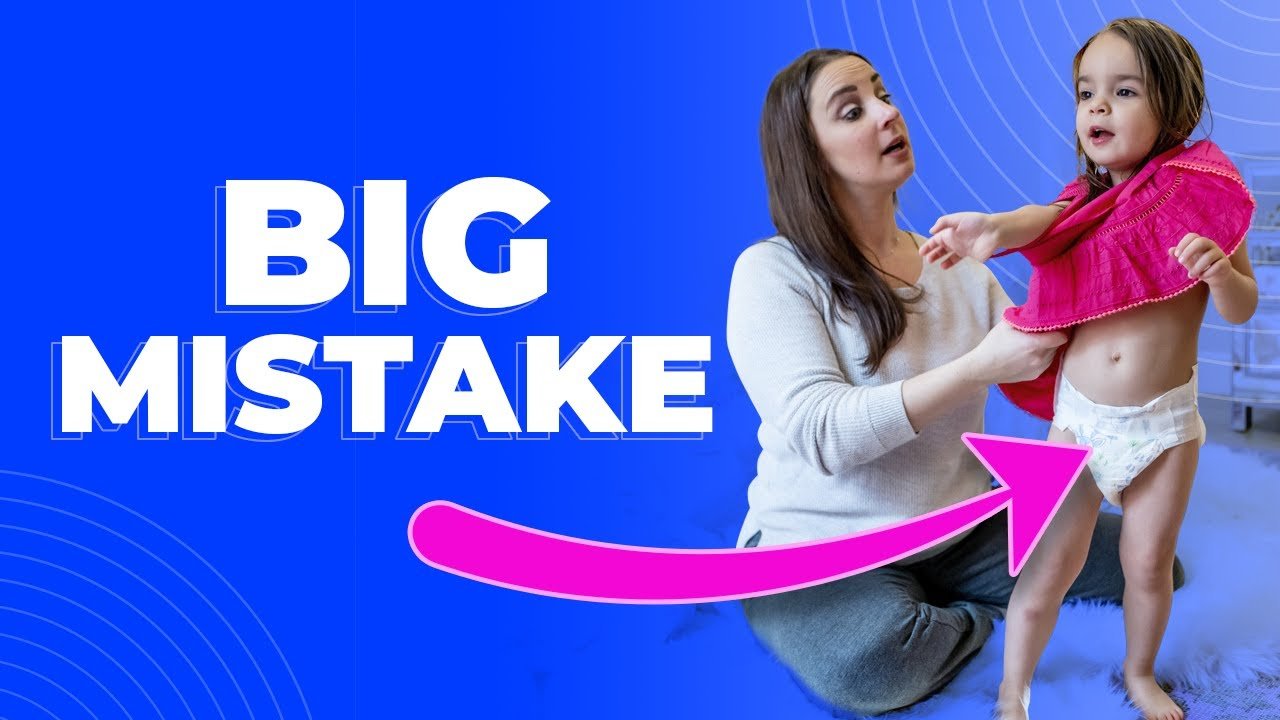When it comes to potty training, there are some common mistakes that many parents unknowingly make. These mistakes can make the process harder than it needs to be. In a video by Emma Hubbard, she covers six of the most common mistakes in potty training, including taking the child to the toilet too often, sitting on the toilet for too long, and overreacting to accidents. By understanding these mistakes and how to avoid them, parents can make the potty training experience easier and more positive for both themselves and their children.
Parents often receive advice from friends and family members that is based on myths and old wives’ tales, leading them to make mistakes in potty training. It’s important to create a positive potty training environment and not overreact to accidents. By following the tips provided by Emma Hubbard in her video, parents can navigate the potty training process more effectively and set their children up for success in learning this important milestone.

Common Mistakes in Potty Training
Potty training can be a challenging time for both parents and children. It is common for parents to make mistakes that can inadvertently make the potty training process harder than it needs to be. Some of the most common mistakes include taking the child to the toilet too often, sitting on the toilet for extended periods, asking the child if they want to go to the toilet, using pull-ups, overreacting to accidents, and pushing for poo in the potty or toilet.
Taking child to toilet too often
Parents often believe that taking their child to the toilet frequently will help in toilet training. However, constantly taking the child to the toilet can be counterproductive. Children need to learn to recognize the signals from their bodies indicating they need to go to the toilet. Taking them too often may prevent them from developing this awareness. It is essential to establish a routine for toilet breaks instead of taking the child every time they are in the vicinity of a bathroom.
Sitting on toilet too long
Allowing a child to sit on the toilet for extended periods can create negative associations with the potty training process. Children should only sit on the toilet for a maximum of five minutes at a time. Prolonged sitting can make the experience feel like a punishment and may not be conducive to successful toilet training.
Asking child if they want to go to the toilet
Children may not yet have a full understanding of when they need to go to the toilet. Instead of asking the child if they want to use the toilet, observe for signs that indicate they need to go. By recognizing these signals and guiding the child to the toilet at the appropriate time, you can create a more successful toilet training experience.
Using pull-ups
While pull-ups may seem like a convenient option for managing accidents during potty training, they can hinder the learning process. Pull-ups absorb moisture, preventing children from feeling the discomfort of being wet. This sensation is crucial for them to understand the association between using the toilet and staying dry. Consider using training pants or underwear as a more effective alternative.
Overreacting to accidents
Accidents are a natural part of the potty training process, and it is essential not to overreact when they occur. Reacting negatively to accidents can create anxiety and fear in children, impacting their willingness to use the toilet. Stay calm and supportive during accidents, focusing on guiding the child through the cleanup process without adding stress or pressure.
Pushing for poo in potty/toilet
Forcing a child to do a poo in the potty or toilet can lead to resistance and constipation. It is important to respect the child’s readiness and comfort level when it comes to bowel movements. Providing alternatives, such as using a nappy in the bathroom, and creating a supportive environment in the toilet area can help children feel more at ease with the process.
Advice from Friends and Family
When it comes to potty training, parents often seek advice from friends and family members who have gone through the process themselves. While this support can be valuable, it is essential to discern between helpful guidance and outdated myths or old wives’ tales.
Myths and old wives tales
Common potty training myths may include beliefs such as starting too early is best, or that certain techniques guarantee quick success. It is crucial to distinguish between accurate information and outdated advice that may hinder the potty training process.
The impact of following incorrect advice
Following incorrect advice can lead to confusion and frustration for both parents and children. Myths surrounding potty training may set unrealistic expectations and create unnecessary pressure. It is important to evaluate the advice received and seek guidance from reliable sources to ensure a positive and effective potty training experience.
Seeking guidance from reliable sources
When seeking advice on potty training, it is advisable to consult with reliable sources such as pediatricians, child development experts, or reputable parenting resources. These sources can offer evidence-based information and practical tips to support successful toilet training. By prioritizing accurate guidance, parents can make informed decisions and approach potty training with confidence.
Importance of Not Overreacting to Accidents
Accidents are a normal part of the potty training process and should be handled with patience and understanding. It is essential to create a positive environment that supports the child’s learning and development during this transitional phase.
Creating a positive potty training environment
Establishing a positive and encouraging atmosphere during potty training can help children feel more comfortable and confident in their abilities. Celebrate successes, no matter how small, and provide gentle guidance and support during accidents.
Encouraging child after accidents
After an accident occurs, offer reassurance and comfort to the child. Avoid blaming or shaming them for mistakes, as this can negatively impact their self-esteem and progress in potty training. Instead, focus on guiding them through the cleanup process and reinforcing positive behaviors.
Teaching child that accidents are normal
Helping children understand that accidents are a natural part of the learning process can alleviate stress and anxiety around potty training. By normalizing accidents and emphasizing progress over perfection, parents can create a supportive environment that fosters growth and confidence.
Tips for Easier Potty Training
Navigating the challenges of potty training can be more manageable with practical tips and strategies that promote consistency and positive reinforcement.
Establishing a routine
Creating a consistent toilet schedule can help children anticipate and respond to their bathroom needs effectively. Set regular times for toilet breaks, such as after meals or before bedtime, to establish a routine that supports successful potty training.
Using positive reinforcement
Encouraging and praising children for their efforts and successes can motivate them to continue practicing proper toilet habits. Positive reinforcement, such as verbal encouragement, small rewards, or stickers, can reinforce positive behaviors and make potty training more engaging for children.
Rewarding successes
Celebrate milestones and achievements in the potty training journey with rewards that motivate and incentivize progress. Consider creating a reward system that acknowledges successful toilet trips or staying dry throughout the day, reinforcing positive behaviors through positive reinforcement.
Being patient and consistent
Patience is key during potty training, as progress may vary for each child. Stay consistent in your approach, even in the face of setbacks or challenges. By remaining patient and reinforcing positive behaviors consistently, you can help your child build confidence and develop successful toilet habits over time.
Making potty training fun and interactive
Engage children in the potty training process by making it fun and interactive. Incorporate games, songs, or books related to potty training to make the experience enjoyable for the child. By creating a positive and engaging atmosphere around toilet training, parents can enhance the learning process and encourage active participation from the child.
Empowering Parents with Correct Information
Educating parents about effective potty training techniques and dispelling common myths can empower them to approach toilet training with confidence and success.
Empowering parents to make informed decisions
By providing parents with accurate and evidence-based information on potty training, they can make informed decisions that support their child’s developmental needs. Empowering parents with the knowledge and resources to navigate potty training challenges can enhance their confidence and efficacy in guiding their child through this milestone.
Providing resources for effective potty training
Offering parents access to reliable resources, such as parenting books, online articles, or reputable organizations, can supplement their understanding of potty training best practices. Access to practical tips, expert advice, and supportive communities can equip parents with the tools and strategies necessary for a successful potty training experience.
Encouraging open communication with healthcare professionals
Maintaining open communication with healthcare professionals, such as pediatricians or child psychologists, can offer valuable insights and support during the potty training process. Consulting with trusted professionals can provide tailored guidance and recommendations based on the child’s individual needs and developmental readiness.
Understanding Child’s Developmental Readiness
Recognizing the signs of readiness and adjusting to the child’s pace are crucial factors in promoting a successful and stress-free potty training experience.
Signs of readiness for potty training
Children exhibit various signs that indicate their readiness for toilet training, including showing interest in the toilet, staying dry for longer periods, communicating their needs effectively, and demonstrating physical readiness for using the toilet. By observing these cues and responding appropriately, parents can facilitate a smoother transition to independent toileting.
Avoiding starting too early
Pushing a child to start potty training before they are developmentally ready can lead to resistance and setbacks. It is essential to wait until the child shows signs of readiness and demonstrates a willingness to participate in the potty training process. Starting too early can create unnecessary stress and frustration for both the child and the parent.
Adjusting to child’s pace
Every child progresses at their own pace during potty training, and it is important to respect their individual development and learning style. Adjusting the approach to meet the child’s needs and abilities can foster a supportive and positive environment that encourages confidence and success in toilet training. By following the child’s lead and offering guidance as needed, parents can promote a healthy and effective approach to potty training.
Addressing Specific Challenges in Potty Training
Certain challenges, such as resistance, regression, or nighttime training, may arise during the potty training process. Understanding how to navigate these obstacles can help parents overcome setbacks and maintain progress in toilet training.
Dealing with resistance or fear
Children may exhibit resistance or fear towards using the toilet for various reasons, such as discomfort, anxiety, or unfamiliarity with the process. Addressing these concerns with patience, reassurance, and understanding can help children overcome their fears and develop confidence in using the toilet independently. By acknowledging and validating their feelings, parents can support their child through moments of resistance and encourage positive toilet training behaviors.
Handling regression in potty training
Regression, or a temporary setback in toilet training progress, is a common occurrence among children learning to use the toilet. Factors such as stress, changes in routine, or new environments can contribute to regression behaviors. By acknowledging regression as a normal part of the learning process and offering consistent support and encouragement, parents can help their child navigate through periods of regression and regain confidence in their toilet training skills.
Managing night-time potty training
Night-time potty training presents unique challenges compared to daytime training, as children often have less control over their bladder while asleep. Implementing strategies such as limiting fluids before bedtime, establishing a consistent nighttime routine, and using protective bedding can support children in managing night-time accidents and transitioning to dry nights. By approaching night-time potty training with patience and understanding, parents can help their child achieve nighttime dryness in a supportive and positive manner.
Positive Reinforcement and Encouragement
Using positive reinforcement techniques and fostering a supportive environment can promote motivation and confidence in children throughout the potty training journey.
Using praise and rewards effectively
Praising children for their efforts and achievements in toilet training can boost their self-esteem and encourage continued progress. Incorporating rewards, such as stickers, small treats, or special privileges, can reinforce positive behaviors and motivate children to engage actively in the potty training process. By offering praise and incentives, parents can create a positive and encouraging atmosphere that fosters success and enjoyment in toilet training.
Building child’s confidence
Encouraging children to take ownership of their potty training journey and celebrating their accomplishments can build their confidence and self-esteem. Empowering children to participate in toileting tasks, make choices regarding their bathroom routine, and express their feelings about the process can enhance their sense of agency and independence. By nurturing children’s confidence and autonomy in toilet training, parents can instill a positive mindset and attitude towards learning and development.
Creating a supportive environment
Creating a supportive and nurturing environment during potty training can alleviate stress and anxiety for both parents and children. Providing clear and consistent expectations, offering gentle guidance and encouragement, and respecting children’s pace and preferences can help establish a positive and trusting relationship in toilet training. By fostering a safe and supportive atmosphere, parents can promote open communication, collaboration, and mutual respect throughout the potty training process.
Consistency in Potty Training Approach
Developing a consistent and structured approach to potty training can enhance effectiveness and promote successful outcomes in toilet training.
Developing a consistent schedule
Establishing a regular routine for toileting breaks and bathroom visits can help children anticipate and respond to their bathroom needs. Consistency in timing, frequency, and duration of toilet training sessions can reinforce positive habits and expectations, supporting children in developing independence and confidence in using the toilet.
Following through with established routines
Maintaining consistency in potty training routines and expectations is essential for reinforcing learning and progress. By adhering to established guidelines, rules, and practices, parents can provide a structured and reliable framework that supports children’s toilet training development. Consistent follow-through with established routines can help children feel secure, motivated, and empowered to engage actively in the potty training process.
Communicating expectations to caregivers
Collaborating with caregivers, such as family members, childcare providers, or educators, can facilitate a cohesive and unified approach to potty training. Clear communication of expectations, strategies, and progress updates can ensure consistency and support across various settings and environments. By involving caregivers in the potty training process and sharing information effectively, parents can promote a collaborative and coordinated effort that enhances children’s learning and development.
Conclusion
Potty training is a significant milestone in a child’s development that requires patience, understanding, and support from parents and caregivers. By recognizing common mistakes, seeking reliable advice, and implementing effective strategies, parents can navigate the challenges of toilet training with confidence and success. Empowering both parents and children with correct information, positive reinforcement, and consistency can foster a positive and rewarding potty training experience. By approaching potty training proactively and positively, parents can help their children achieve independence and confidence in this essential life skill.

